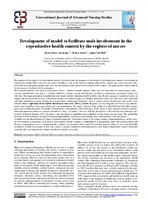| dc.contributor.author | Jooste, Karien | |
| dc.contributor.author | Amukugo, Hans Justus | |
| dc.contributor.author | Van Dyk, Agnes | |
| dc.date.accessioned | 2016-04-07T20:11:45Z | |
| dc.date.available | 2016-04-07T20:11:45Z | |
| dc.date.issued | 2015 | |
| dc.identifier.citation | Amukugo, H.J. et al. (2015). Development of model to facilitate male involvement in the reproductive health context by the registered nurses. International Journal of Advanced Nursing Studies, 4(2): 122-130 | en_US |
| dc.identifier.issn | 2227-488X | |
| dc.identifier.uri | http://hdl.handle.net/10566/2107 | |
| dc.description.abstract | The purpose of this article is to describe the process followed in the development of the model of facilitating male partner involvement in reproductive health (RH) context by the nurses. Namibia is one of the African countries affected by cultural and socio-economic influences that have persuaded gender roles in a way that hinders male-partner involvement in RH context. This phenomenon make difficult for the nurses to facilitate their involvement.
The research methods were done in four phases. Phase 1 entitled concepts analysis. Phase one was done into two steps namely step1 - concepts identification and step 2 - concepts definition. During concept identification, qualitative, exploratory, descriptive design was followed. The target population included male and female partners attending health facilities and all nurse managers (registered nurses in charge) that provided RH services in the health facility in a northern region in Namibia. Individual interviews and focus were conducted until data saturation occurred. During the research three fundamental principles such as respect person, beneficence and justice were adhered. Tech’s eight steps of descriptive data analysis were used. Three (3) main categories, six (6) categories and twelve (12) subcate-gories were identified using open coding and conceptualization. The main concepts of the model were identified and classified using a survey list of Dickoff, James, Wiedenba (Dickoff,James, Wiedenbach, 1968; Mckenna, 2006). Phase 2 dealt with the creation of interre-lationship statements between concepts identified in step 1. In phase 3 focuses with the description of the model using strategies pro-posed by (Chinn & Kramer, 1991). In phase 4, the description of guidelines and evaluation for the model was also done. The applied the principle of trustworthiness through developing dependability, credibility, transferability and confirmability in all four phases.
A model was developed based on a theory generated approach. The model consist of five phase namely, situational analysis in the exter-nal environment (community) and internal environment (health facilities); establishment of partnership (male and female partner and Nurses), management process, maintaining the conducive environment and control & terminus/ outcome phase. It was concluded that facilitation of Male involvement in RH care context is needed. Further the recommendations were made to implement a model within the current health care framework in which reproductive health is provided. | en_US |
| dc.language.iso | en | en_US |
| dc.publisher | Science Publishing Corporation | en_US |
| dc.rights | Copyright authors
The International Journal of Advanced Nursing Studies is an open access journal, all content is freely available without charge. | |
| dc.source.uri | http://dx.doi.org/10.14419/ijans.v4i2.5018 | |
| dc.subject | Development | en_US |
| dc.subject | Model | en_US |
| dc.subject | Facilitate male involvement | en_US |
| dc.subject | Reproductive health | en_US |
| dc.subject | Context and the registered nurse | en_US |
| dc.title | Development of model to facilitate male involvement in the reproductive health context by the registered nurses | en_US |
| dc.type | Article | en_US |
| dc.privacy.showsubmitter | false | |
| dc.status.ispeerreviewed | true | |
| dc.description.accreditation | Unknown | en_US |

